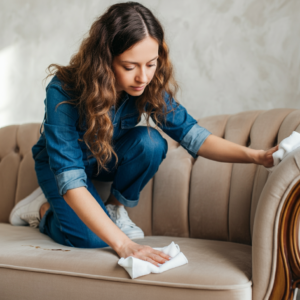Upholstery Spot or Stain Removal
- Colorado Carpet Masters

- Nov 14, 2024
- 3 min read
Updated: Nov 17
Remove Spots from Upholstery
“As an Amazon Associate, I earn from qualifying purchases”

When you notice a stain on your upholstery, it’s crucial to act quickly to minimize damage. You might think a simple wipe will do, but the right techniques can make all the difference. From food spills to pet accidents, each type of stain requires a different approach. Knowing which cleaning supplies to have on hand and the steps to take can save your furniture. But what happens when a stain just won’t budge? That’s where the real challenge begins, and you’ll want to be prepared for the unexpected. Some furniture needs to be cleaned by a professional upholstery cleaning company. There are several fabrics that will water stain if you do not clean the whole fabric panel and some antique furniture that can crock or bleed if the wrong upholstery cleaning product is used.
Common Upholstery Stains
When it comes to keeping your furniture looking fresh, knowing about common upholstery stains is essential for homeowners and pet owners alike. Food and beverage spills, pet accidents, ink marks, and dirt tracked in from outside can wreak havoc on your upholstery. Grease stains from pizza or fried foods can be particularly tough, often needing a solvent-based cleaner to tackle the oils. For protein-based stains like blood or urine, enzyme cleaners work wonders by breaking them down at a molecular level. Ink or red wine stains require immediate attention and specialized removers to prevent permanent damage. Remember, regular vacuuming and promptly blotting spills can significantly reduce the chances of stains setting in, making future cleaning a breeze. A PH neutral product that can be used on most fabrics is Miss Mouth’s Messy Eater Stain Treater Spray. This product is known to be able to remove food, coffee, grease, catsup, blueberries and even ink. Always follow directions and test on an inconspicuous area first.
Step-by-Step Removal Techniques
Act Quickly: The sooner you treat a stain, the easier it will be to remove. Blot up any excess liquid using a clean cloth or paper towel, avoiding any rubbing that can spread the stain.
Test Cleaning Solution: Before applying any cleaning product, test it on an inconspicuous area of the upholstery to ensure it doesn’t cause discoloration or damage.
Blot with a Cleaning Solution:
Water-Based Stains (Juice, Coffee, etc.): Mix a small amount of mild dish soap with warm water. Dampen a clean cloth with the solution and gently blot the stained area.
Oil-Based Stains (Grease, Makeup, etc.): Use a specialized upholstery cleaner or sprinkle cornstarch or baking soda on the spot. Let it sit for 15-20 minutes to absorb the oil, then vacuum it up and proceed with blotting using dish soap and water.
Rinse and Blot Dry: After blotting the stain with a cleaning solution, dampen a clean cloth with water and blot to remove any residue. Blot with a dry towel to absorb excess moisture.
Repeat if Necessary: Some stains may require multiple treatments. Repeat steps 3 and 4 until the stain is gone.
Avoid Over-Saturation: Be mindful of how much water or cleaning solution you’re using, as excess moisture can soak into the upholstery padding, leading to mildew or mold.
Air Dry Completely: Allow the treated area to air dry naturally. You can use a fan to speed up the drying process, ensuring no dampness lingers in the upholstery.
In conclusion, tackling upholstery stains doesn’t have to be daunting. By knowing the common types of stains and having the right supplies on hand, you can effectively manage spills and spots. Remember to act quickly, use the appropriate cleaning techniques, and take preventative measures to keep your upholstery looking great. If a stain proves stubborn despite your efforts, don’t hesitate to call in a professional. Keeping your furniture clean enhances its lifespan and keeps your space inviting.



Comments